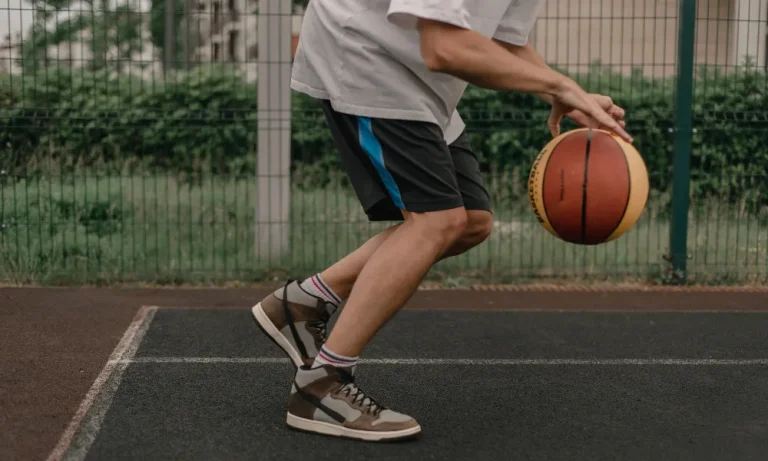The Kick Ball Rule in Basketball: Explained
Have you ever wondered why basketball referees blow their whistle when a player kicks the ball? Well, my friend, you’re about to find out! In basketball, there’s a rule called the kick ball rule, and it’s more than just a simple whistle-blower. In this article, we’ll dive deep into what the kick ball rule is all about and why it’s crucial for players, coaches, and fans to understand it. So, let’s get started and unravel the mysteries of this important basketball rule!
What is the Kick Ball Rule?
The kick ball rule in basketball is a fundamental regulation that governs the use of a player’s feet or legs to intentionally or unintentionally move the ball. It states that if a player deliberately kicks the ball or strikes it with any part of their leg below the knee, it results in a violation. This rule ensures fair play and prevents teams from gaining an unfair advantage by using their feet to control or manipulate the ball.
During gameplay, the kick ball rule comes into play in various situations. For example, if a defender tries to block a pass by extending their leg and the ball hits their foot, it is considered a kick ball violation. Similarly, if an offensive player intentionally uses their foot to redirect the ball, it is also a violation. However, if the ball unintentionally hits a player’s foot while they are in motion, it may not be considered a violation, as long as it does not give them an advantage.
The intention behind the kick ball rule is to maintain fair play and uphold the principles of basketball. By prohibiting the use of feet and legs to control the ball, the rule ensures that players rely on their skills, such as dribbling, passing, and shooting, to advance the game. It promotes a level playing field where players compete on an equal footing, without resorting to unfair tactics.
What Constitutes a Kick Ball?
To understand what constitutes a kick ball violation in basketball, it’s important to be aware of the various scenarios that can lead to such an infraction. A kick ball violation occurs when a player intentionally or unintentionally uses their foot or leg to strike or redirect the ball.
Actions that are considered intentional include deliberately kicking the ball or intentionally striking it with any part of the leg below the knee. On the other hand, unintentional kick balls occur when the ball inadvertently hits a player’s foot or leg while they are in motion, without any intentional action on their part.
It’s worth noting that there are certain instances where a player’s leg or foot coming into contact with the ball is not considered a kick ball violation. For example, if the ball is passed or bounced off a player’s foot by an opponent, it does not result in a violation. Similarly, if a player is attempting to make a steal or block a shot and the ball inadvertently hits their leg, it is not considered a kick ball violation.
Misconceptions regarding the kick ball rule often arise from the interpretation of intent. It’s important to understand that the rule takes into account the player’s intention behind the action. Accidental contact with the ball, such as when a player is attempting to jump or move, does not typically result in a violation unless it provides an unfair advantage.
How is the Kick Ball Rule Enforced?
Referees play a crucial role in enforcing the kick ball rule in basketball. They are responsible for closely monitoring the game and ensuring that players adhere to the regulations. When it comes to the kick ball rule, referees are vigilant in identifying any violations and making the appropriate calls.
Penalties or violations associated with a kick ball vary depending on the situation and the intent behind the action. If a player is deemed to have intentionally kicked or struck the ball with their leg, it results in a turnover, with the opposing team gaining possession of the ball. In some cases, a technical foul may be called if the action was particularly flagrant or done with malicious intent.
Determining whether a kick ball has occurred involves a combination of observation and judgment from the officials. Referees rely on their experience and knowledge of the game to assess the player’s intent and the impact of the action on the course of play. They consider factors such as the player’s body positioning, the movement of their leg, and the effect of the contact on the ball’s trajectory or possession.
It’s important to note that referees may consult with each other or use video replay technology to ensure accurate enforcement of the kick ball rule. This helps in making fair and informed decisions, especially in situations where the action happens quickly or is difficult to observe in real-time.
Strategies and Tactics Involving the Kick Ball Rule
The kick ball rule in basketball can be utilized by teams as a strategic advantage, both offensively and defensively. Understanding the rule and its implications can help teams devise effective game plans to gain an edge over their opponents.
Offensively, teams can use the kick ball rule to their advantage by deliberately aiming for the opponent’s legs or feet when passing or shooting. By doing so, they increase the chances of the ball bouncing off an opponent’s leg, resulting in a kick ball violation. This strategy can lead to turnovers and additional opportunities for the offensive team to score.
Defensively, teams can employ tactics that involve using their legs or feet to disrupt the opponent’s ball movement. By strategically positioning themselves and actively attempting to deflect the ball with their legs, defenders can create chaos and force the offensive team into committing kick ball violations. This disrupts the flow of the game and can lead to turnovers in favor of the defensive team.
There have been numerous instances where the kick ball rule played a significant role in famous basketball plays. For example, in a crucial playoff game, a player intentionally kicked the ball out of bounds to stop the clock and prevent the opposing team from scoring. This savvy move resulted in a kick ball violation and allowed the player’s team to regain possession and secure the victory. Such strategic use of the kick ball rule demonstrates how teams can exploit the rule to their advantage in critical game situations.
Controversies and Interpretations of the Kick Ball Rule
The kick ball rule in basketball has been a topic of debate and controversy in various instances, leading to discussions about its interpretation and application. There have been situations where the enforcement of the rule has sparked disagreements among players, coaches, and fans.
One area of controversy arises when determining the intent behind a player’s action. The rule specifies that a kick ball violation occurs when a player intentionally strikes or kicks the ball with their leg. However, interpreting intent can be subjective, and different officials may have varying opinions on whether a player’s action was deliberate or accidental. These differences in interpretation can lead to disagreements and frustrations, as teams and fans may feel that the rule is inconsistently applied.
The kick ball rule can have a significant impact on the outcome of important games. In close matches, a kick ball violation can result in a crucial turnover, leading to a shift in momentum or even a game-winning opportunity for the opposing team. The interpretation and enforcement of the rule in these critical moments can have a direct influence on the final result. Therefore, controversies surrounding the kick ball rule can be particularly intense, as the stakes are high and every call matters.
Evolution of the Kick Ball Rule
The kick ball rule in basketball has evolved over time to adapt to the changing dynamics of the game. Understanding the historical development of the rule sheds light on its significance and the rationale behind various modifications and updates.
The kick ball rule was initially introduced to prevent players from gaining an unfair advantage by intentionally kicking the ball. In the early days of basketball, the rule was relatively simple, stating that any intentional striking or kicking of the ball with the leg constituted a violation. However, as the game evolved and strategies became more sophisticated, it became necessary to refine the rule to address new challenges.
One significant modification to the kick ball rule was the introduction of the concept of intent. Initially, any contact between the ball and a player’s leg was considered a violation, regardless of intent. However, this led to controversies and inconsistencies in enforcement. To address this, the rule was updated to require intentional striking or kicking of the ball with the leg for it to be considered a kick ball violation. This change aimed to provide a fairer assessment of player actions and reduce unnecessary stoppages in the game.
The rationale behind these changes was to promote a more fluid and continuous style of play, while still preventing players from gaining an unfair advantage through deliberate kicking. By requiring intent, officials could make more accurate judgments about whether a kick ball violation had occurred, reducing disputes and maintaining the integrity of the game.
Conclusion
Basketball is a dynamic sport with rules that govern player actions on the court. One such rule that often sparks controversy and debates is the kick ball rule. In this blog post, we delved into the controversies and interpretations of the rule, highlighting instances where it has sparked debates and the different interpretations by referees. We also explored how the rule can impact the outcome of important games. Additionally, we traced the historical development of the kick ball rule, explained modifications over time, and discussed the rationale behind these changes.
FAQs: The ‘Kick Ball’ Rule in Basketball: Explained
What constitutes a kick ball violation in basketball?
A kick ball violation occurs when a player intentionally strikes or kicks the ball with their leg.
Can a kick ball violation be accidental?
No, the rule specifies that the action must be intentional for it to be considered a kick ball violation.
Who determines whether a kick ball violation has occurred?
The referees and officials on the court are responsible for interpreting and enforcing the kick ball rule.
How does the interpretation of intent impact the rule’s application?
Different officials may have varying opinions on a player’s intent, which can lead to disagreements and inconsistencies in enforcement.
Can a kick ball violation impact the outcome of a game?
Yes, a kick ball violation can result in turnovers and game-changing opportunities for the opposing team, potentially affecting the final result.
Has the kick ball rule been modified over time?
Yes, the rule has evolved to address challenges and enhance fairness, with updates focusing on the introduction of intent as a determining factor.





